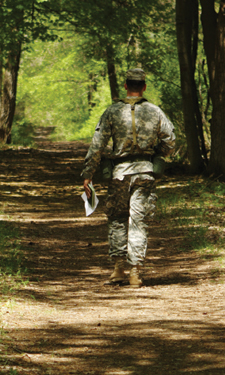 It’s true that active military personnel are required to participate in physical activity on a daily basis. But health and wellness is more than a good workout. It also encompasses healthy living, proper nutrition and emotional well-being. For park and recreation professionals working in the armed forces, this full scope is especially important as they work to address the overall health and wellness of more than 5 million active and reserve personnel and their families. Accomplishing this mission requires focus, innovation and outreach.
It’s true that active military personnel are required to participate in physical activity on a daily basis. But health and wellness is more than a good workout. It also encompasses healthy living, proper nutrition and emotional well-being. For park and recreation professionals working in the armed forces, this full scope is especially important as they work to address the overall health and wellness of more than 5 million active and reserve personnel and their families. Accomplishing this mission requires focus, innovation and outreach.
At the highest level, the Department of Defense (DoD) supports two key initiatives aimed at the health of armed forces personnel and their families. The first is Operation Live Well, which focuses on “proper nutrition, physical activity, avoidance of risky behaviors and emotional well-being.” At the core of this initiative is a website that serves as a portal for information and military-related programs that center on five key areas: integrative wellness, physical activity, nutrition, tobacco-free living and mental wellness. In addition to information and program links, this site offers coaching, downloadable apps for tracking physical activity and nutritional intake, and links to virtual training resources.
Supporting Operation Live Well is the Healthy Base Initiative (HBI), a yearlong program that launched this year at 14 sites across the country. According to the website, “obesity and tobacco use among U.S. military healthcare beneficiaries add more than $3 billion per year to the DoD budget in healthcare costs and lost duty days.” To combat these issues, HBI will work with installation-based schools on healthy eating, create a new health and wellness assessment for military personnel and their families, and focus on tobacco education and smoking cessation.
In addition to these high-level initiatives, each branch of the military, as well as each installation, has its own programs, resources and initiatives aimed at addressing the health and wellness of active and reserve personnel and their families as well as retirees. Here are just a few examples of innovative health and wellness programs taking place in the armed forces.
- Mission Nutrition is a Navy initiative aimed at curbing obesity. The program has many facets, including training for Morale, Welfare and Recreation (MWR) fitness instructors and culinary specialists on nutrition topics affecting sailors, family members and retirees. In addition, the program’s website offers healthy recipes as well as detailed information to help sailors understand what they eat and the impact it has on their energy levels.
- Since family schedules can be hectic, the Air Force is experimenting with 24-hour fitness centers and delivering on-demand fitness classes via video kiosks.
- The U.S. Army Garrison in Ansbach, Germany, participated in Europe Fitness Day. This event was designed to celebrate fitness and health within the European military communities. In Ansbach, this resulted in an increase in the number of people visiting and experiencing the fitness center. The event was also an opportunity to partner with Army Community Services as well as representatives from the health clinic.
- Embracing the adventure run trend, the Naval Submarine Base in Kings Bay, Georgia, will launch Convergent Force, a mud run training team, in January 2014. The program is designed for single sailors, Marines and Coast Guardsmen, and it includes physical training, weekly healthy cooking classes and scheduled nutrition counseling.
- In support of HBI, the Fort Belvoir Commissary in Virginia expanded its farmers’ market and incorporated a “Farmacy,” a demonstration booth that gave visitors a prescription message that good health begins with the right food choices.
- Employees at the McNamara Headquarters Complex at Fort Belvoir, Virginia, now have access to a bikeshare program. The program started in June and bikes can be used by any employee.
Each military branch and installation has its own health and wellness programs because, as Bethany Sweatman, a management analyst for the Defense Logistics Agency’s Installation Support Business Office at Fort Belvoir, puts it, “There’s no one-size-fits-all when it comes to fitness. People have different needs, interests and things they enjoy doing.” With a wide range of opportunities, as well as innovative new programs, the military is working hard to ensure servicemen and women and their families remain healthy, fit and strong.
Learn more about Operation Live Well.
Peter Magnuson is NRPA’s Director of Marketing.

